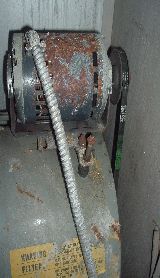|
 |
FURNACE FAN BELT
The fan belt is in good condition but the blower motor and blower (or air handler) are not. A leaky float and overflowing pan in the humidifier above the blower motor, are the cause for all this rust.
Fan belts and humidifiers should be checked annually to prevent this from happening.
Direct-drive furnace motors have by-and-large eliminated the use of fan belts. |
|
|
..
.
|
| Forced Air Heating - Gas |
|
| .... |
Need more information? Use our search box
Furnace with induced draft fan. High efficiency or condensing furnace. Furnace fan belt.
Gas furnace with induced draft fan (mid efficiency). Furnaced equipped with built-in induced draft fans offer energy savings compared to a conventional furnace. Their electrically operated fans force the combustion by-products through a small vent to the outdoors A chimney is no longer needed.
Condensing or high efficiency furnaces have an induced draft fan that eliminates the need for a chimney. In addition, the heat exchangers are larger and more efficient than in a conventional furnace.
Continuous condensing furnaces feature a first-stage steel heat exchanger and a second-stage stainless steel heat exchanger. The water vapour contained in the flue gasses is condensed into a liquid within the steel heat exchanger. This condensation process recovers a substantial amount of heat which in non-
condensing furnaces is lost to the outdoors. The residual water is drained into the floor drain.
Condensing furnaces have either a conventional gas burner burner or a pulse combustion burner. |

High efficiency or Condensing furnace
|
The pulse combustion burner is located in a specially designed combustion chamber. It burns gas in a constant series of rapid pulses that force combustion gases through the heat exchangers which then transfer the heat to the house.
A condensing furnace with a pulse combustion burner does not require a pilot light or a conventional burner. Flue gas temperatures are reduced and less heat is lost to the outdoors.
Heat exchangers. Gas and oil furnaces may look different but they have many components in common, like the heat exchanger.
The flame itself and the by-products of combustion like water vapour, carbon monoxide, carbon dioxide and sulpher, do not come in direct contact with the air being used for heating the house. The heat exchanger transfers the heat from the combustion chamber to the air used for heating the house.
The heat exchanger is an important part of the furnace. A faulty heat exchanger (cracks or rusted through) can leak combustion by-products (including carbon monoxide) into the distribution or supply ducts. In most cases the entire furnace has to be replaced if the heat exchanger is cracked or rusted through.
Fan belt. The fan belt should be adjusted if the slack is more than 1/2" (13 mm). If the smaller pulley is much warmer than the large one, tighten the belt. If the belt is too loose, less air will be moved and energy wasted.
Cracked, frayed or worn belts should be replaced at once to ensure uninterrupted service. |
|
|
|